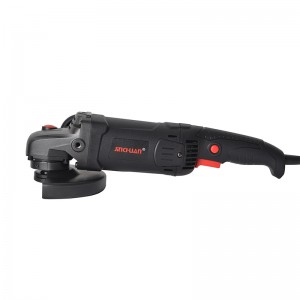When using a 2200W professional Angle grinder, many people tend to overlook the importance of power supply configuration. What seems like a simple connection between a plug and a socket is actually related to the normal operation, work efficiency and even usage safety of the equipment. There are essential differences between the power supply systems in industrial sites and home environments. Understanding these differences can help us use professional Angle grinders more reasonably.
The 2200W power of a professional Angle grinder means it requires a stable and sufficient power supply. This is just like a car needs to be matched with the corresponding grade of fuel. The greater the power of the equipment, the higher the “quality” requirements for the power supply. Household power supplies and industrial power supplies have obvious differences in their design intentions. Household power supplies mainly meet the needs of low-power devices such as lighting and household appliances in daily life, while industrial power supplies are designed to cope with the continuous high-intensity operation of large machinery and heavy tools.
In terms of power supply stability, industrial power systems are usually equipped with more complete voltage stabilizing devices. This is because when multiple devices are operating simultaneously in the factory, the power load will change frequently. The voltage stabilizing system can ensure that the voltage always remains within a reasonable range. During the cutting or grinding process of professional Angle grinders, the instantaneous power may exceed the rated value. The voltage stabilization capability of industrial power supplies can prevent the equipment from being damaged due to voltage fluctuations. In contrast, the voltage stabilization capacity of household power supplies is relatively weak, especially during peak electricity consumption periods. Voltage fluctuations may cause the Angle grinder to suddenly slow down or shut down.
The carrying capacity of the power line is another major difference. Wires in industrial sites usually use thicker copper core materials, which can withstand greater current passing through. When the 2200W Angle grinder is in operation, it generates a continuous large current. Thick wires can effectively reduce power loss and line heating. However, the cross-sectional area of wires in ordinary households is relatively small. Prolonged use of high-power devices may cause the lines to overheat, posing safety hazards. This is also why when multiple high-power electrical appliances are used simultaneously in a household circuit, tripping is prone to occur.
The design of sockets and plugs also reflects the differences between the two. Industrial sockets typically adopt a three-phase design. This structure can distribute power more evenly and reduce vibration and noise during equipment operation. Three-phase plugs have a larger contact area and are less likely to generate electric sparks during insertion and extraction, making them suitable for frequent usage scenarios. Most household sockets are designed as single-phase. Although they can meet the basic power supply requirements of Angle grinders, during long-term high-load operation, the contact points between the plug and the socket may oxidize due to overheating, affecting the electrical conductivity.
Grounding protection measures are more complete in industrial power supply systems. Professional Angle grinders pose an electric shock risk during metal processing. The multiple grounding design of industrial power supplies can quickly conduct leakage current into the ground, ensuring the safety of operators. Although household power supplies also have grounding devices, their protection level is relatively low. Especially in old houses, the grounding lines may be aged or poorly connected, and thus cannot provide reliable protection.
It is worth noting that there are also differences in the continuous power supply capacity of the power source. Industrial power systems are supported by more powerful transformers and can maintain high power output for a long time. Household electricity usage is limited by the capacity of the community transformer. If a 2200W Angle grinder is used for a long time, it may cause the transformer to overload, affecting the stability of power supply in the entire area.
After understanding these differences, when using a professional Angle grinder in a home environment, some protective measures should be taken. For instance, avoid using other high-power electrical appliances simultaneously, choose dedicated sockets and extension cords, and regularly check if there is any overheating in the circuits, etc. If frequent or long-term use is required, it is best to consult an electrician to make necessary modifications to the household circuit to meet the power demands of the equipment.
In conclusion, the 2200W professional Angle grinder has specific requirements for power supply configuration. The difference between industrial power supply and household power supply directly affects the performance of the equipment and the safety of use. Whether using such tools in a factory workshop or a home garage, the power supply conditions should be evaluated first to ensure that the equipment operates in a suitable power environment. Only in this way can both work efficiency be guaranteed and the occurrence of safety accidents be avoided.
Post time: Sep-18-2025

